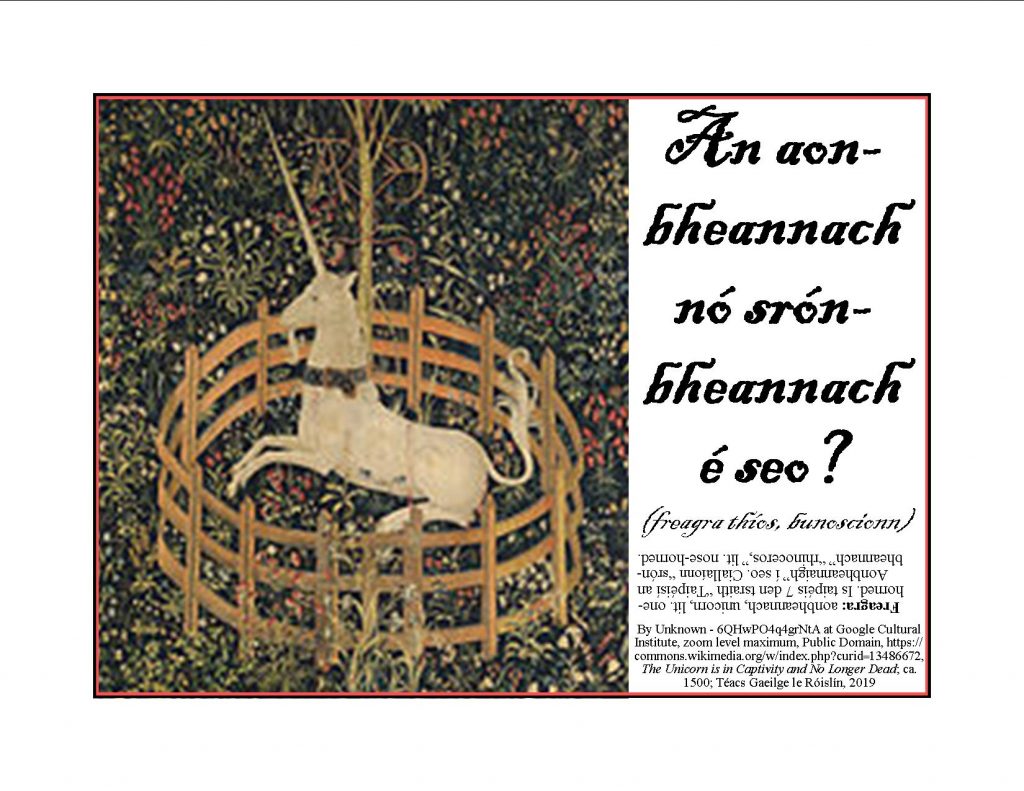Unicorn or rhinoceros? Compound words with ‘-bheannach’ in Irish Posted by róislín on Jan 20, 2019 in Irish Language
(le Róislín)
By now, you may have guessed — the Irish for unicorn is “aonbheannach,” (lit. one-horned”). Or you may have picked up the word from reading _Harry Potter agus an Órchloch_ (Harry Potter and the Philosopher’s Stone, aka Harry Potter and the Sorcerer’s Stone) by J. K. Rowling and translated into Irish by Máire Nic Mhaoláin.
But the “aonbheannach” isn’t the only animal whose name is a compound word ending in “-bheannach.” What are the other two – and yes, there’s at least one more besides the “srónbheannach” mentioned in the graphic above.
So let’s look a little closer at the following words: beann (the core word for all of these), aonbheannach, srónbheannach, and our third quadruped player, the “biorbheannach.”
1)) Beann: antler, prong, tine. It can mean “horn” but doesn’t usually since there are at least two other words for horn, such as “adharc” for an animal or “corn” for a musical instrument or cornucopia. Not to be mistaken for two other words with the same spelling: beann (regard, dependence) and beann (the plural possessive form of “binn”, a mountain peak, gable, cliff, corner, flange, side, etc.). The latter is perhaps more recognizable in its other plural form, beanna, as in the Scottish song “Chì mi na mórbheanna”, which under its English name, “Mist-Covered Mountains” was among the musical pieces played at President John F. Kennedy’s funeral.
Here are some other forms of the word “beann” with the meaning “antler,” “prong,” or “tine”:
an bheann, the antler, etc.
na binne, of the antler, etc.
na beanna, the antlers, etc.
na mbeann, of the antlers, etc.
And now, the subject of “Taipéisí an Aonbheannaigh”:
2)) an t-aonbheannach, the unicorn (lit. “the one-horned one”)
an aonbheannaigh, of the unicorn
na haonbheannaigh, the unicorns
na n-aonbheannach, of the unicorns
If you’re wondering why the phrase “the unicorn” has an inserted “t” (an t-aonbheannach), it’s because it’s a masculine singular noun and so gets the “t” just like “an t-uisce” and “an t-úll.” So why is there no “t” in the question used as a caption for the graphic above (“An aonbheannach nó srónbheannach é seo?”), it’s because there are two different words spelled “a-n” in Irish. One means “the” (as in “an bhean”, the woman) and may cause the “t” insertion (an t-uisce, the water)… The other indicates that a question is coming up (technically, the “interrogative particle”). You’ve probably seen it in front of verbs (“An bhfuil tú go maith?“) but it may be less familiar before nouns. It is used before nouns and pronouns fairly frequently, however, in questions like “An móidín Doctor Who thú?” (Are you a Doctor Who fan?) and “An tusa Seán?” Are you “Seán”? or “Sa chistin, an ea?” (In the kitchen, is it?).
Our next “-bheannach” word is “srónbheannach” (lit. nose-horned)
3) an srónbheannach, the rhinoceros
an tsrónbheannaigh, of the rhinoceros
na srónbheannaigh, the rhinoceroses
na srónbheannach, of the rhinoceroses
The genitive singular form (an tsrónbheannaigh) was pleasantly immortalized in Gabriel Rosenstock’s “cnuasach” of poetry, _Spéaclaí an tSrónbheannaigh / The Rhino’s Specs_ (Mercier Pres, 2002). Perhaps you have already read it? It’s great for learners, since it’s bilingual.
Finally, one more animal that is “beannach” (no lenition there because I’m using the word on its own, not part of compound word. “Beannach” by itself can mean “antlered,” “pronged,” etc.
4) biorbheannach, pronghorn, sometimes translated as “antelope” but it’s not technically an antelope. “Bior” on its own means “pointed rod,” “pointed shaft,” “a spit,” “a spike” or “a point.” In combination with other words it can mean a nail, a bit, a stick, a pick, a spindle, a file, etc.
Here are its forms:
an biorbheannach, the pronghorn
an bhiorbheannaigh, of the pronghorn
na biorbheannaigh, the pronghorns
na mbiorbheannach, of the pronghorns
There are at least two types of biorbheannach: Meicsiceach and Tuaidh-Mheiriceánach. Can you figure out where they’re from? Ní as Éirinn iad, ar aon chaoi.
So there we have three animals described as “beannach,” with the “beannach” element built in as part of a compound word. There are a few more “beannach” types of animals, and some plants, but their names are not constructed as “comhfhocail.” These include the following animals: scuilpin bheannach an Aigéin Chiúin (Pacific staghorn sculpin) and coiréalach beannach (stag’s horn coral, yes, it is animal even though it’s sometimes confused with being a plant or even a rock) and the following plant: glasair bheannach (pyramidal bugle – a leithéid d’ainm!). And then there’s one whose kingdom (or whatever) I’m not really sure of because I think all its member have been reclassified: glóthfhungas beannach (the charmingly named “jelly antler fungus,” LA Calocera viscose). So what’s the latest, an bhfuil a fhios agat – are fungi actually plants or their own category? But anything further about the “beanna” involved with these will have to wait for “blag éigin eile.”
SGF — Róislín
Naisc:
http://www.jfklibrary.org/learn/about-jfk/life-of-john-f-kennedy/fast-facts-john-f-kennedy/president-kennedys-funeral-music

Build vocabulary, practice pronunciation, and more with Transparent Language Online. Available anytime, anywhere, on any device.





Leave a comment: